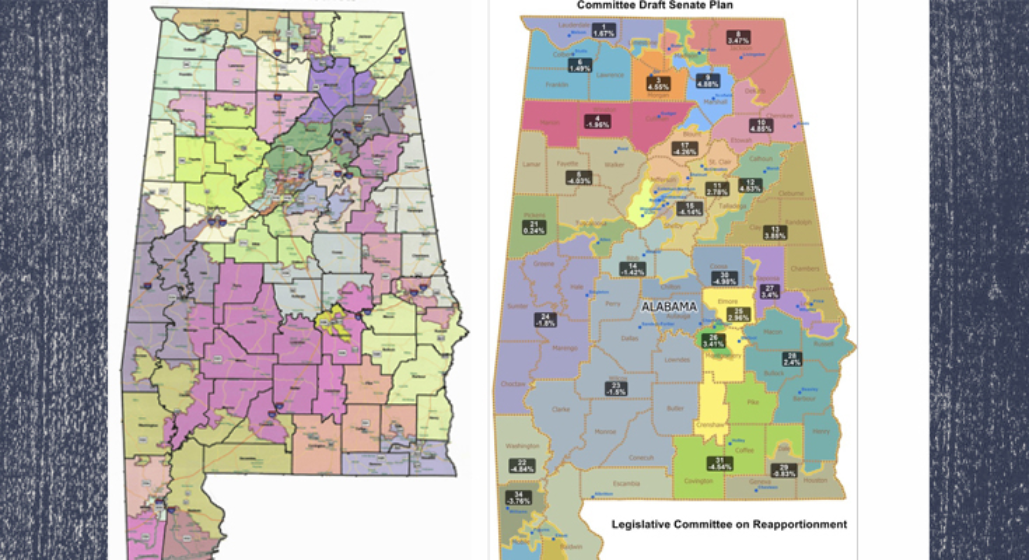By Brandon Mosley
Draft maps were released Monday showing the proposed redistricting maps for the Alabama House of Representatives and Alabama Senate. The draft redistricting plans will be considered by the joint Legislative Committee on Reapportionment.
The proposed new Alabama House of Representatives and Senate districts look very different from the current configuration, reflecting changes that occurred in Alabama’s population over the last decade.
The Alabama Legislative Committee on Reapportionment will meet Tuesday ahead of Thursday’s special session on redistricting to consider the proposed reapportionment and redistricting plans for not just the state legislature, but also Congressional Districts and the state Board of Education.
The Committee is composed of members of both the Alabama House of Representatives and the Alabama Senate. They are tasked with preparing new districts every 10 years based on the most recent Census results. In this case, the new districts are based on the 2020 Census, which was delayed by difficulties in performing the Census during the COVID-19 pandemic, as well as the changeover in administrations in Washington.
The committee proposed reapportioning each of the Alabama State Senate districts to an ideal district population of 143,551, but in actuality the proposed new Senate districts vary from a low of 136,395 to a high of 150,708.
People in Alabama have historically voted along racial lines. Blacks in Alabama in recent elections have typically voted over 90% for Democrats, while Whites typically voted over 80% for Republicans. That is reflected in the makeup of the Alabama Senate. There are 35 State Senate districts, 27 of which are currently represented by Republicans, who are all White. The Democratic minority is comprised of seven Blacks and one White. Republicans presently hold all of the majority White districts in the state, while Democrats hold all of the majority minority districts.
A lawsuit was brought in the early 1980s by former State Rep. Joe Reed (D) in which the federal court ordered the state to create more majority minority districts. A second lawsuit 30 years later challenged the 2012 redistricting plan because, it said, too many Blacks were “packed” into majority minority districts. A second redistricting plan was adopted in 2017 to comply with the ruling in that federal court case. The Committee has had to redistrict both Houses of the Alabama legislature, while having to be in compliance under both, somewhat conflicting, federal court rulings. There are still majority minority districts, but they are more diverse than the districts drawn under the 2012 plan, which was tossed out by the court.
Under the proposed plan, Alabama Senate District 28 (parts of Elmore and Montgomery Counties and all of Crenshaw) is 53.09 percent Black and 39.49% White. It is presently represented by State Sen. Billy Beasley (D-Clayton) who is White. That is the most diverse district in the State Senate.
Some districts in rural Alabama cover a vast territory geographically. The proposed Senate District 23 is comprised of eight counties: Lowndes, Perry, Wilcox, Monroe, Conecuh, Dallas, Butler, and Clarke Counties. It is currently represented by State Sen. Malika Sanders-Fortier (D-Selma). The rural district will continue to be one of the majority minority districts with 56.3% Blacks and 40% Whites.
Some Democrats had hoped for a new majority minority district in Huntsville, which became Alabama’s largest city in 2020, but that apparently will not happen. There was also some discussion that the Black Belt could lose a majority minority seat since those counties have declined in population at a precipitous rate. That also was avoided in this proposed redistricting.
The Committee is chaired by State Sen. Jim McClendon (R-Springville) and State Rep. Chris Pringle (R-Mobile). The Committee has held numerous public hearings on redistricting in the past weeks, but Tuesday will be the first time that the public or other legislators will see the actual maps.
This is not a definitive breakdown of the proposed new state Senate districts and is based on early analysis by 1819 News. The Committee could reject these maps and demand changes. If accepted by the redistricting committee, both Houses of the state legislature would still have to approve them in the special session that begins Thursday, Oct. 28.










